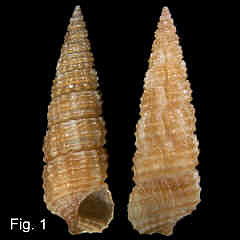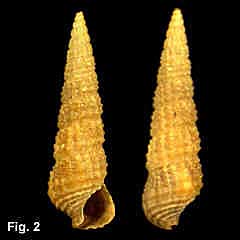|
|
|
|
|
Cacozeliana icarus (Bayle, 1880) Description: Teleoconch 9-10 whorls in adult shells. Spire whorls with 3 or 4 beaded spiral ribs aligned on axial folds. Body whorl with 3-5 beaded ribs above periphery, beads sometimes becoming obsolete on lower ribs, and a few unbeaded spirals on base. Varix present as a low, broad fold on dorsal surface of body whorl; sometimes earlier varices present, spaced half whorl apart. Columella smooth, body whorl expanded, outer lip thin and smooth internally. Anterior canal very short; posterior canal well defined in mature shells. Colour white, fawn, tan or dark brown, sometimes with a brown band at top of whorls and on base. Operculum corneous. Size: Up to 8 mm in length. Distribution: Endemic to Australia; Port Stephens, NSW, around southern Australia and Tasmania to southern WA. Habitat: Known from the intertidal down to 35 m, from the open coast and estuaries. Common. Comparison: This species is smaller and narrower than Cacozeliana granaria. It reaches an adult size of 8 mm with 9-10 whorls, while C. granaria reaches 17 mm (in NSW) with 10-12 whorls. The varix on the dorsal surface of the body whorl is always present and strong in this species, but weak, if present at all, in C. granaria. Synonymy: Cerithium tenue Sowerby, 1855 (not Deshayes, 1834); Bittium variegatum Brazier, 1894; Bittium furvum Watson, 1886 Remarks: The range in NSW will probably be extended as unsorted museum material is identified. Fig. 1: Gunnamatta Bay, Port Hacking, NSW (C.327658) Fig. 2: Careel Bay, Pittwater, NSW (C.327722) |

